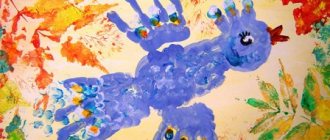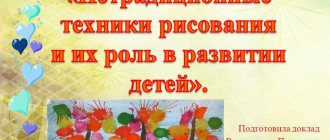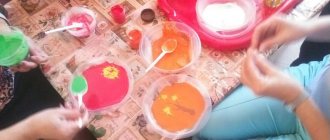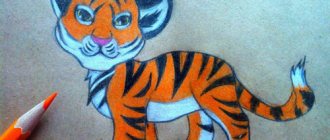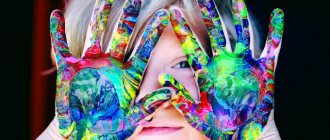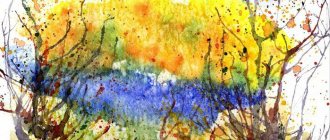Creative project in fine art in the senior group Miracles and only (5-6 years old)
Creative project in the senior group using
methods and techniques of unconventional drawing
“Miracles and nothing more”
Author of the project: Krivko O. G. 2021.
Implementation period: October-April.
Project participants: children of the senior group, teacher, parents.
Type of project: long-term, group, long-term.
Relevance of the project:
Drawing is an interesting and useful activity in which pictorial and graphic images are created in a variety of ways using a variety of materials. A child creates according to his age.
Project goal: To study the process of development of creative abilities in children of senior preschool age through non-traditional drawing.
Objectives: Select specific forms of non-traditional drawing according to the age of the children.
To study the development of children's creative abilities while using methods and techniques of non-traditional drawing.
Help children master various technical skills when working with non-traditional techniques.
To develop children's aesthetic sense of form, color, composition.
Develop creativity and imagination.
Practical part
Finger painting
Means of expression: spot, dot, short line, color.
Materials: bowls with gouache, thick paper of any color, napkins.
Method of obtaining an image: the child dips his finger in the gouache and puts dots and specks on the paper. Each finger is painted with a different color.
Palm drawing
Means of expression: spot, color, fantastic silhouette.
Materials: wide saucers with gouache, brush, large format sheets, napkins.
Method of obtaining an image: the child paints his palm with a brush and makes an imprint on paper.
Impression with cork
Means of expression: stain, texture, color.
Materials: a bowl or plastic box containing a stamp pad made of thin foam rubber impregnated with gouache, thick paper, cork seals.
Method of obtaining an image: the child presses the cork to a staple pad with paint and makes an impression on the paper.
Potato stamp imprint
Means of expression: stain, texture, color.
Materials: a bowl with a foam pad soaked in gouache, paper, potato stamps.
Method of obtaining an image: the child presses the signet to the stamp pad and makes an imprint on thick paper.
Imprint with crumpled paper
Means of expression: stain, texture, color.
Materials: a saucer containing a foam rubber stamp pad soaked in gouache, thick paper, crumpled paper.
Method of obtaining an image: the child presses the crumpled paper to the stamp pad and makes an impression.
Subject monotype
Means of expression: spot, symmetry, color.
Materials: thick paper of any color, brushes, gouache or watercolor.
Method of obtaining an image: the child folds a sheet of paper in half and draws half of the depicted object on one half. After drawing, until the paint has dried, the sheet is folded in half to make a print. The missing details are completed.
Blotography with a tube
Means of expression: stain.
Materials: paper, thinly diluted gouache in a bowl, plastic spoon, drinking straw.
Method of obtaining an image: the child scoops up paint with a plastic spoon, pours it onto the sheet, making a small spot. Then blow on this stain from a tube so that its end does not touch either the stain or the paper. The missing details are completed.
Wax crayons + watercolor
Means of expression: stain, texture, color.
Materials: wax crayons, thick white paper, watercolor, brushes.
Method of obtaining an image: the child draws with wax crayons on white paper. Then he paints the sheet with watercolors in one or more colors. The chalk drawing remains unpainted.
Methods and techniques for implementing the project: conversation, looking at illustrations, memorizing poems, experimenting, productive activities.
Expected results: identification and awareness by the child of his abilities. Children's speech is enriched. Fine motor skills of the hands, thinking, imagination, and positive emotions when asked to draw develop.
Progress of the lesson.
We wind the yarn onto a rectangular piece of cardboard, then cut it off from one edge. Place the yarn on the edge of the green paper and coat it with glue. Roll it together with the paper into a tube.
The kids really enjoyed these activities. They became emotionally liberated. They felt comfortable and happy. They especially liked that the teacher gave them the opportunity to work independently. Emphasizing that they are already adults.
I believe that such activities are of great benefit. They can be done by older and even middle school children.
Short-term project in the senior group “Magic and Colors”
Children finish drawing bubbles. As the drawing progresses, guiding questions are asked, if necessary.
- Reflection.
Game “Good - Bad” (TRIZ)
Additional education teacher:
Guys, tell me, what's good about bubbles?
Children:
They are beautiful, you can play with them, they make us happy.
Additional education teacher:
What's wrong with bubbles?
Children:
They burst and can get into your eyes and sting.
Additional education teacher:
Well done, you know everything!
Additional education teacher:
So you and I have achieved real magic, a real miracle.
-Let's see who did what they did (works are being examined, the additional education teacher praises the children for their invention and resourcefulness).
-Guys, did you like drawing with bubbles?
-What was the most difficult thing for you?
-What's easy?
Children share their impressions.
Guys, you also drew bubbles today and I suggest finishing them in the group and organizing an exhibition of works called “The Tale of Soap Bubbles”
Consultation for parents
«
Drawing in unconventional ways"
The development of the creative potential of an individual should be carried out from early childhood, when a child, under the guidance of adults, begins to master various types of activities, including artistic ones. Great opportunities for the development of creativity lie in visual arts and, above all, drawing. Drawing is an important means of aesthetic education: it allows children to express their ideas about the world around them, develops fantasy and imagination, and makes it possible to consolidate knowledge about color and shape. In the process of drawing, the child improves his powers of observation, aesthetic perception, aesthetic emotions, artistic taste, creative abilities, and the ability to independently create something beautiful using accessible means. Drawing classes develop the ability to see beauty in the surrounding life, in works of art. Own artistic activity helps children gradually approach an understanding of works of painting, graphics, sculpture, and decorative and applied art. The image in the drawings is created using a variety of materials. Artists use various materials in their work: various chalks, paints, charcoal, sanguine, pastels and much more. And in children's creativity it is also necessary to include different paints (gouache, watercolor), ink, crayons, and teach children to use these visual materials in relation to their means of expression. Experience shows that drawing with unusual materials and original techniques allows children to experience unforgettable positive emotions. Emotions, as we know, are both a process and a result of practical activity, primarily artistic creativity. By emotions one can judge what pleases, interests, depresses, worries the child at the moment, what characterizes his essence, character, and individuality. Preschoolers, by nature, are able to sympathize with a literary hero, to play out various emotional states in a complex role-playing game, but to understand what beauty is and learn to express oneself in visual activity is a gift that one can only dream of, but it can also be taught. We adults need to develop a sense of beauty in a child. It depends on us how rich or poor his spiritual life will be. It should be remembered: if the perception of beauty is not supported by the child’s participation in the creation of beauty, then, as they say, “infantile enthusiasm” is formed in the child. In order to instill a love of fine art and arouse interest in drawing starting from early preschool age, it is necessary to use non-traditional methods of depiction. Such unconventional drawing gives children a lot of positive emotions, reveals the possibility of using objects well known to them as artistic materials, and surprises them with their unpredictability. Unusual methods of drawing captivate children so much that, figuratively speaking, a real flame of creativity flares up in the group, which ends with an exhibition of children's drawings. What non-traditional painting methods can you use at home? Blotography, salt painting, finger painting. Soap bubbles, splashing, etc. Wouldn't you like to know what happens when you draw with a rag or crumpled paper? You can draw however you want and with anything! Lying on the floor, under a table, on a table... On a leaf of a tree, on a newspaper... The variety of materials poses new challenges and forces you to come up with something all the time. And from the scribbles and scribbles, a recognizable object eventually emerges - the Self. The uncomplicated joy of satisfaction from the fact that “I did this - it’s all mine!” Having learned to express his feelings on paper, the child begins to better understand the feelings of others, learns to overcome shyness, fear of drawing, of the fact that nothing will work out. He is confident that it will work out, and it will turn out beautifully. Mastering various materials, ways of working with them, and understanding their expressiveness allows children to use them more effectively when reflecting their impressions of the life around them in drawings. The variety of visual materials makes visual activity more attractive and interesting, and as children master different materials, they develop their own style of depiction. One of children's favorite ways to draw unconventionally is painting with salt. It not only has interesting decorative capabilities, but is also very easy to use. Children love to draw and...with soap bubbles. You can draw using the blowing method. But you can draw with a toothbrush, cotton wool, your finger, your palm, a tampon, crumpled paper, a tube driving paint (a drop) across a sheet of paper, print with different objects, create compositions with a candle, lipstick, feet... Go ahead, get creative! And joy will come to you - the joy of creativity, surprise and unity with your children. Drawing art has a variety of techniques and they should be used when working with children. The use of various materials enriches children with knowledge of how to work with them, their visual capabilities, will make children's drawings more interesting, and will increase the aesthetic side of the drawing.
